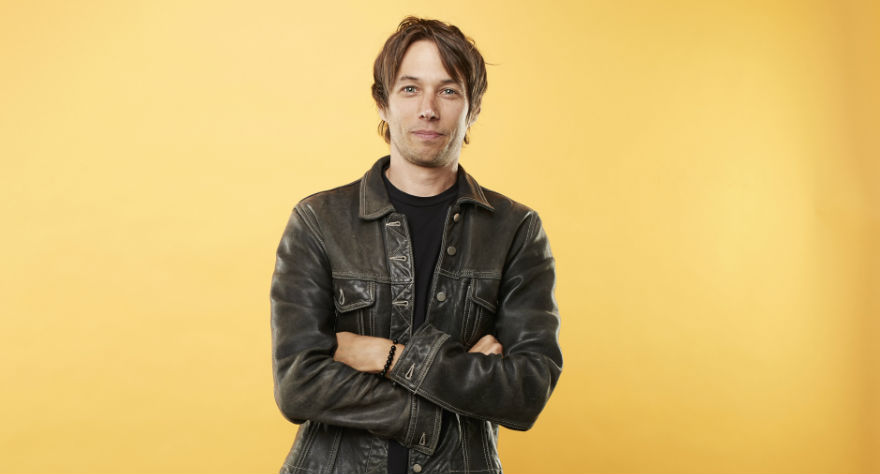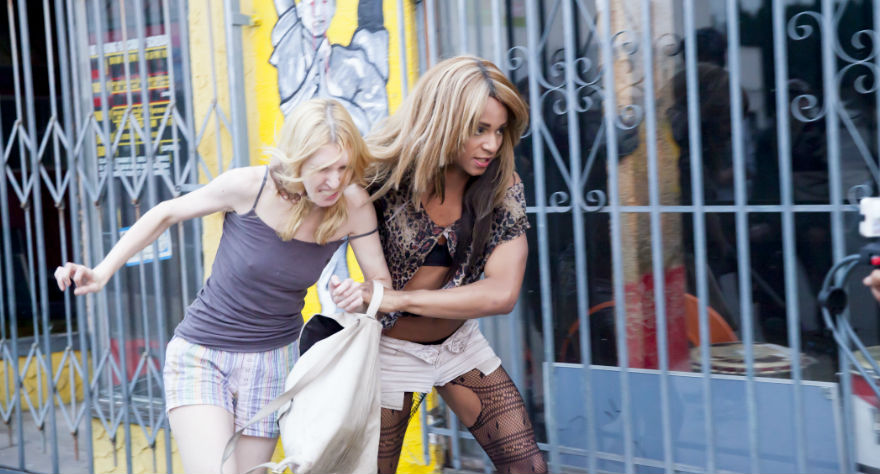Sean Baker On ‘Tangerine,’ Marrying Disney and Arthouse

Independent filmmaking is the art of making a lot with a little. There are few filmmakers out there who have mastered this better than Sean Baker, whose micro-budget productions Prince of Broadway and Starlet have carved out a special spot for him in today’s crowded indie landscape.
Baker goes indie-er than ever with Tangerine, the Sundance smash shot on iPhone 5s. Baker and cinematographer Radium Chung accentuate the positives of their tech limitations by painting a frantic, swirling, ultraviolet portrait of Los Angeles the likes of which we’ve never seen. The story follows two transgender sex workers—Alexandra (Mya Taylor) and Sin-Dee (Kiki Rodriguez)—on a wild night of drugs, violence, prostitution and revenge inspired almost exclusively by true-to-life stories.
I spoke to Sean during his visit to San Francisco about his experience making the film, which is out now in select cities and opens in SF this Friday, July 17.

Talk about your collaboration process with Chris.
We’ve now made two features together, Starlet and Tangerine. We’ve also written other scripts that are hopefully getting made. It’s an interesting way of working. We break the story together, and in both cases we’ve gone through an extensive research process. With Tangerine, we had no idea what story we were going to tell. We didn’t go into this world knowing we were going to tell this story of boyfriend vengeance.
So you picked the milieu first.
Oh yeah, yeah. I did that with my film Prince of Broadway and also Take Out, which I co-directed. We found the location first and decided to collaborate with the people who inhabit this world and find the story with them. In this case, we had months of Mya Taylor telling us stories, and those anecdotes got sprinkled throughout the film. Then, it was Kiki who actually told us the story of this one transgender prostitute who found out her boyfriend was cheating on her with a fish. As soon as we heard that, we realized it was such a layered plot that we could make it our A plot and sprinkled the anecdotes around it. When we realize we have something that can be our beginning, middle and end, we walk away and break it down and figure out the scenes. Then, we ask each other which scenes we’re most happy with. We choose the scenes, write them and share them with each other.
We try to use modern technology as much as possible. I think we wrote all of Starlet on two different coasts on Goggle Drive. For this one, we were in the same city at the same time, but we’d literally share screens sometimes and write together. If I wasn’t 100% happy with what he did, I’d try to re-write it or vice versa. Then we have a “script-ment,” which is basically half-script, half-treament. It was around 70 pages. It has dialogue but some of it is left open for improvisation. This film had a whole other element with the Armenian side of the plot. In that case, we were able to use our friend Karren Karagulian, who played Razmik, to collaborate. He’s one of my best friends and has been in all my films. He’d take our dialogue and give it authentic Armenian texture and flavor.
What about the girls?
We also took the “script-ment” to Mya and Kiki and asked if they approved. They loved it. They were nervous about the last scene. The reason it’s the last scene is that we realized through our research that it was something incredibly important and difficult for them. They’re dealing with identity every day, and to strip that away and be forced to show something you don’t want to show to the world is really difficult. I give them props for doing that scene. We only shot it once, one take. You can read on Kiki’s face how nervous she is. It was the hardest scene for them to shoot, and for us, too. They didn’t want anybody to see them. We had to have PAs make sure none of their friends could see into the laundromat from the parking lot. I knew that we had it in one take, and I wasn’t going to put them through it again.
With scenes like that and movies like yours, you really get to see people get their hands dirty. It feels real.
Well, we definitely got our hands dirty. I hate that it’s almost necessary. Mary Shelley said something like, “It’s sad that better art comes from chaos.” It’s a catch-22: you have to put yourself and your crew through this to make something that stands out. This is the fourth time I’ve done it, and it takes a toll on everybody.
Talk to me about your editing process. Are you thinking about the audience as you edit?
I have gotten to the point where I’m just making films for myself. I actually don’t like watching my movies with an audience. Chris does. He watches every screening. I pop my head in. I’m disciplined with the editing, so I know I’m getting it to that specific runtime and I’m not going overboard. I’m okay with whether jokes work or not. As long as they work for me, it’s fine. I don’t believe in test screenings. Would Lars Von Trier or Paul Thomas Anderson do that? I don’t think so. You have to be confident with what you’re putting out there. You also have to be aware of audience expectations, but as long as I know people are out there with a certain sensibility, I’m confident.
Ricky Gervais said on one of his interview shows that he’s never going to dumb down his stand-up comedy or write for other people. He said, “I write for myself. Hopefully there are enough people out there to fill the theater.”
He’s a genius. He’s the best. I always quote and tweet him.
I find it interesting that Chris watches your screenings and you don’t.
I think the reason our partnership works is that we come from different schools. I lean toward real arthouse, independent stuff and foreign films. He’s very mainstream and is in love with Disney. He knows everything about Disney and Spielberg and Lucas. If I wrote this film by myself, it would probably have no plot and be slow as molasses. He would make a fantasy film with a fairy tale ending. We meet somewhere in the middle.
Makes sense when I think back to the film.
I think it makes sense for Starlet, too. You can see a lot of Chris in there. Even with the title. The double-meaning with naming the dog Starlet and thinking it refers to her career. That’s all Chris.
Do you get tired of talking about the iPhone thing?
I don’t get tired of it. I’m sure I will eventually. But it’s something I was surprised about myself. The whole reason we shot on the iPhone came from a very organic place. We didn’t have the budget to shoot on higher formants. We could’ve gotten away with something small, like a DSLR, but that would’ve added crew members and added to the presence I didn’t want on the street. We had no idea until we were actually shooting how valuable the tool was. I was using two first-timers in the lead roles, so these girls had smartphones between takes that they were taking selfies with. I realized early on that there wasn’t that hump I had to get over like I had to with my other films.
In my other films, when I was working with first-time actors and shoving a camera in their face, it took a few days for them to get comfortable. [But in Tangerine], they were comfortable within a minute. It didn’t even feel like we were making a feature film—it felt like we were making home movies. They had the confidence level of the other seasoned actors on-set because of the iPhone.
I know the necessity for the iPhones came from an organic place, but hopefully this movie will inspire young filmmakers to make movies with whatever tools they have available.
I hope so. I’ve been hearing that, and we’ve been getting a lot of nice, very positive messages on Facebook and Twitter. If this has helped in any way, shape or form, we’re happy. I know that [DP] Radium Chung came from shooting 35mm on The Americans and was shooting iPhone on our movie the next week. For him, there was that moment when he said, “What am I DOING?” [laughs] “I’m a professional cinematographer getting on Variety’s Top 10 to Watch list. I can’t believe I’m shooting on an iPhone!” But I think that what we realized was that the only way to make this film good was to embrace it and say, “Look, we’re going to take advantage of every benefit this thing can bring. Yes, it’s not going to look like 70mm, but it’s going to be as cinematic as possible, and we’re going to use how small it is and how inconspicuous it can make us to capture something that a 70mm camera wouldn’t.”
